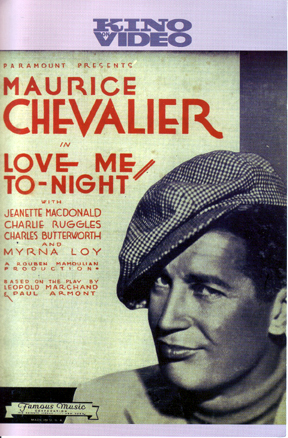
(845) 246-6944 ·
info@ArtTimesJournal.com
Love Me Tonight: An Appreciation of a Great Almost Forgotten Musical Film
 |
By
FRANK BEHRENS
ART TIMES October 2007
Most
of the earlier movie musicals
were concerned with a troupe putting on a musical. The best of them
is “42nd Street,” many of the others a pale imitation of that wonderful
work. A good many other film musicals are simply fair or not at all
faithful transcriptions of a stage show to the screen.
However, now and then there is a musical written specifically
for the screen that really works.
The Astaire-Rogers films had wonderful
music and exquisite dancing, while the plots were lame, predictable
and juvenile. A rare treat like “Seven Brides for Seven Brothers” was
a welcome exception in which every element just worked! In this essay,
I want to turn my readers’ attention to an even more exceptional musical
film from 1932 called “Love Me Tonight.”
Designed as a vehicle for Maurice
Chevalier and Jeanette MacDonald, it boasts a fabulous score by Richard
Rodgers and Larry Hart. The slim plot, alas, depends on the very wealthy
MacDonald mistaking the lowly tailor Chevalier for an aristocrat when
he comes to her chateau to be paid for his work by Charlie Ruggles.
So much for the story.
The film opens as does no other film
musical in my recollection. In silence. A quiet street
in Paris at sunup. Clock bells chime. A worker comes out to pound with
a rhythmic beat a hole in the road. He is joined by a man snoring, a
woman with a broom, some chimneys spouting smoke, a crying baby, the
metal door guard to a shop being rolled up, a blanket being snapped
to be aired out, two cobblers at their laths, a knife grinder, a woman
beating a carpet, some car horns—each with a contrasting beat—until
a young girl puts on a phonograph record to bring some melody onto the
scene. This provides the background for Chevalier’s first number, “The
Song of Paree,” which carries him from his flat to his shop.
After some rhythmic and rhymed dialogue
with a customer, Chevalier begins “Isn’t It Romantic?” with some male-chauvinist
lyrics (that were changed when the song became a single). The customer
leaves the shop singing part of the lyrics and is overheard by a taxi
driver, who hums the song in the presence of a composer who takes the
cab to the station. Giving the song new lyrics, the composer is overheard
by a troupe of soldiers, who adopt it as a marching song, which is overheard
by a convenient gypsy violinist, who plays a melancholy version to his
people. This is overheard by MacDonald on her balcony and she sings
it with yet newer lyrics—thereby establishing her connection with
the male love-interest far before they meet.
Just before they do meet, she sings
a “throwaway” song to her horse, “Lover,” which became a perennial hit
(much to Rodgers and Hart’s surprise). When they finally meet, Chevalier
calls her Mimi for the sole purpose of introducing another hit song
of the same name. When the tailor is revealed as a non-noble, “The Son-of-a-Gun
is Nothing But a Tailor” is sung first by all the main characters (including
the venerable C. Aubrey Smith in his only singing moment on film) and
then by the downstairs staff.
In short, the team, along with director
Rouben Mamoulian, had found a solution for the musical-comedy question.
How does a musical number advance the plot and at the same time hold
the viewer’s interest in a dark movie house?
(The biggest laugh, by the way, is
a non-musical one. When her sister is ill, the love-starved Myrna Loy
is asked, “Can you go for a doctor?” She brightens up and says, “Certainly.
Bring him right in.”)
In his autobiography, “Musical Stages,”
Rodgers writes that he, Hart and Mamoulian, were “convinced that a musical
film should be created in musical terms—that dialogue, song and
scoring should all be integrated as closely as possible so that the
final product would have the unity of style and design.” They also wanted
“not only moving the camera and the performers, but having the entire
scene move” during musical numbers just as it does in a dialogue
scene. The fact that not every song quite achieves this goal is unimportant
since half of the songs do. (Wouldn’t Wagner have approved?)
Many film versions of stage musicals
overdo this concept by having the singers suddenly shift locations without
missing a beat of the music. This is merely film gimmickry and not what
Rodgers et al. had in mind at all by “movement.”
Now and then, the Turner Classic
Movies cable channel will show this film; and it is available on the
Kino Video label. Well worth seeing.
And I would appreciate nominations
from my readers for other musicals made for film that have high merit.